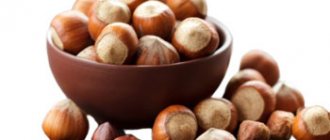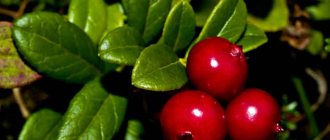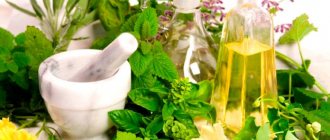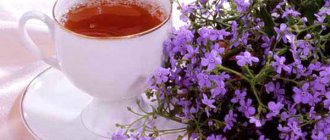The benefits of St. John's wort in gynecology
St. John's wort is known for its high content of biologically active components, due to which the herb is used in the treatment and prevention of a large list of diseases. St. John's wort is also used in gynecology.
St. John's wort helps with female diseases. It contains the following substances:
- essential oils;
- flavonoids;
- tannins;
- bitterness;
- resins;
- saponins;
- hypericin;
- vitamins: ascorbic and nicotinic acids, carotene;
- organic acids;
- minerals: lead, copper, molybdenum, aluminum, nickel, cobalt, cadmium.
Thanks to its rich chemical composition, the plant has the following effects on the woman’s body:
- pain reliever;
- wound healing;
- antiseptic;
- anti-inflammatory;
- restorative.
St. John's wort is also prescribed for bleeding caused by gynecological pathologies. With premenstrual syndrome and during menopause, when a woman’s nervous system suffers from sudden mood swings, its calming effect is an important factor.
The herb promotes rapid tissue restoration, activates blood circulation in the pelvic organs and ensures the delivery of oxygen to cells. St. John's wort has a general strengthening effect on the female body, and also affects the level of prolactin in the blood, a hormone that is responsible for the ability to bear children.
Medicinal raw materials stimulate the production of androgens - male sex hormones. Although their role in the female body has not been fully studied, it is reliably known that androgens are used in polycystic ovary syndrome, in the treatment of infertility, as well as disorders of fat and carbohydrate metabolism.
St. John's wort is used to treat the following gynecological diseases:
- adhesions;
- pathologies of the mammary glands;
- colpitis;
- vulvovaginitis;
- uterine bleeding;
- cervical erosion;
- heavy and painful menstruation;
- menstrual irregularities;
- infertility.
St. John's wort for the treatment of thrush in men
The male body is more protected from the proliferation of yeast fungi than the female body. Therefore, for candidiasis, only local treatment is usually sufficient. But you can’t delay it, since thrush can easily become chronic and cause not only discomfort, but also many complications. There is a high probability that it will provoke the development of:
- chronic prostatitis;
- urinary and kidney diseases;
- infertility.
Treating the disease with St. John's wort is most effective through the use of compresses. They are applied to the penis before bed for 7-10 days in a row. The decoction for compresses is prepared as follows:
- Pour 2 tbsp into the bowl. l. dried St. John's wort.
- Fill with clean water. This amount of herb will require 500 ml of liquid.
- Bring the mixture to a boil and turn off after a minute.
- Cool and filter the medicinal drug.
A similar decoction can be used to wash the genitals and to carefully remove cheesy discharge. If the procedures are carried out regularly, the condition will improve in a few days. But the course of treatment (at least 7 days) should be completed to the end in order to completely cure the thrush.
How St. John's wort is used in gynecology
Based on St. John's wort, decoctions and infusions are prepared, baths and douches are made . They will not completely rid you of the problem, but with complex treatment they will ease the painful symptoms.
The herb is used as a mono-component for the preparation of medicines and combined with other beneficial herbs.
If your period is late
If your period is delayed, mix St. John's wort with valerian, lemon balm and other herbs that have a positive effect on the woman's body. This collection is indicated for amenorrhea, a disease in which menstruation is absent for six months or more. Treatment may take from 1 week to 1 month. For the recipe you will need dried herbs.
Ingredients:
- St. John's wort - 5 tsp.
- Valerian - 2 tsp.
- Sweet clover - 2 tsp.
- Potentilla goose - 4 tsp.
- Melissa - 1 tsp.
- Wormwood - 4 tsp.
- Chamomile - 4 tsp.
- Licorice root - 2 tsp.
- Yarrow - 4 tsp.
- Horsetail - 2 tsp.
- Water - 200 ml.
How to prepare : Mix the ingredients. For a single dose you will need 1 tbsp. mixtures. Pour boiling water over it and leave for 4-6 hours. Filter.
How to use : Before use, warm to 30C. Drink before bed before your period appears.
Result : Restores the menstrual cycle.
For cystitis
Although many people consider this disease to be a female disease, men and children are also susceptible to it. The decoction described below can be used by any category of patients. For children, reduce the dosage by half.
Ingredients:
- St. John's wort (dried) - 1 tsp.
- Water - 200 ml.
How to prepare : Pour boiling water over the herb and leave for a quarter of an hour. Strain. Bring the volume of the decoction to 200 ml with boiled water.
How to use : Drink a glass of the product in equal parts throughout the day. Duration of therapy is 1 week.
Result : Relieves inflammation, reduces pain when urinating.
For colpitis and vulvitis
Colpitis and vulvitis are common gynecological diseases in women of reproductive age. The causes of the disease are many factors, and depending on the etiology of the disease, the doctor will prescribe appropriate therapy for you.
Ingredients:
- St. John's wort - 1 tbsp.
- Centaury - 1 tbsp.
- Water - 200 ml.
How to prepare : Place herbs in boiling water and boil for about 5 minutes over low heat. Let the infusion sit for 15 minutes, then filter it.
How to use : Take 1 tbsp. before meals for 2 weeks.
Result : Soothes itching and burning in the vagina.
For thrush
Vaginal candidiasis causes many unpleasant moments for women. It can be caused by hormonal imbalance, taking medications, stress, lack of personal hygiene and other reasons.
Herbal douches and sitz baths are suitable for treating thrush.
Ingredients:
- St. John's wort (dried) - 50 g.
- Water - 2 l.
How to cook : Pour the herb into boiling water and cook it over low heat for 15-20 minutes. Remove, cool and filter.
How to use : Fill a low basin with warm water and add a decoction there. Sit in your pelvis for 5 minutes.
Result : Relieves inflammation, relieves itching and redness of the labia. Kills harmful microorganisms.
For cervical erosion
For this diagnosis, gauze swabs based on St. John's wort oil are suitable. It will take you 3 weeks to prepare the product.
Ingredients:
- St. John's wort (dried) - 3 tbsp.
- St. John's wort (fresh flowers) - 0.5 tbsp.
- Refined vegetable oil - 200 ml.
How to prepare : Place the raw materials in a glass jar, add oil and close the lid tightly. Place in a cool place and leave for 21 days. Strain. Store in the refrigerator.
How to use : Twist a tampon from sterile gauze, soak it in oil and insert into the vagina. Carry out the procedure at night, be sure to wear underwear and do not forget about sanitary pads so as not to stain your clothes and bedding.
Result : Relieves inflammation, promotes healing of erosions.
You can also use a herbal decoction as a douche.
Ingredients:
- St. John's wort (dried) - 4 tbsp.
- Water - 200 ml.
How to prepare : Pour boiling water over the herb, simmer in a water bath for 10 minutes, then leave for 30 minutes. Filter.
How to use : Fill a 50 ml syringe and inject the solution into the vagina. Carry out the procedure 1-2 times a day for 1-1.5 weeks.
Result : Relieves pain and inflammation on the walls of the uterus.
During menopause
This period in a woman’s life, when reproductive function fades, is characterized by hormonal imbalance. For some women, menopause goes unnoticed, while others experience unpleasant symptoms: hot flashes, irritability and depression, frequent migraines and insomnia, changes in blood pressure and fatigue. And these are just some of the signs.
Ingredients:
- St. John's wort - 1 tsp.
- Mint - 1 tsp.
- Large leaf green tea - 0.5 l.
How to prepare : Pour boiling water over the teapot, place herbs and tea in it, pour boiled water over them. Leave for 5-10 minutes and then pour into cups.
How to use : You can take 1-2 cups of tea per day.
Result : Eliminates nervousness, relieves insomnia, normalizes blood pressure.
St. John's wort herb description
Even knowing about the existence of such a perennial plant, it is not always possible to recognize it among the many beautiful meadow herbs and flowers while relaxing in nature.
The Slavs also call the plant red grass, youth blood, bloodworm, willow herb and healthy grass.
Such names are directly related to many historical legends. And each of them contains drops of blood:
A long-standing pagan legend claims that St. John's wort grew from drops of the blood of a fabulous bird wounded in a fierce battle by a monster;
Catholics believe that blood was “given” to people and nature by John the Baptist after his execution.
Also, the name “St. John’s wort” was based on the practical observation of animals that ate or smelled flowers. After such a procedure, they actually come into a stop and do not react to external irritating factors, which becomes a great help for hunters. But domestic animals with light coats always die.
In any case, St. John's wort has given humanity a lot of benefits and health.
In appearance, the plant resembles a low shrub belonging to the St. John's wort family of the same name.
Its stem is tetrahedral, and the leaves located opposite each other with small black gland dots are characterized by short petioles.
The main element that attracts attention are the relatively large yellow flowers with a brownish tint, having many stamens in their center. They are collected in inflorescences, each of which consists of five sepals and petals. The inflorescences are often located in the upper part of the plant. The main flowering period is summer - from June to August.
The St. John's wort fruit looks like a triangular small box, divided into 3–5 nests. It is in them that small oval-shaped seeds are formed. Nests open after maturation approximately in the first months of autumn. Bloodberry root is branched.
Basically, the plant chooses tropical and temperate climates for growth and is most often found in forest clearings and meadows.
Among the 110 species, the most common are:
Perforated (its stem is dihedral, the leaves are bright green, there are a large number of black spots, which creates the impression of perforation);
Large (features a smooth stem, grows up to a meter in height, the flowers are very large, which is why this species is classified as decorative);
Elongated (maximum height reaches up to 50 cm, there are a lot of flowers, their color is white-yellow, blooms from May to July);
Mountain (cylindrical stem, height varies from 20 to 60 cm, glands are only on the upper leaves);
Attractive (its height is 70 cm, belongs to the multi-stemmed varieties, the leaves are oval-shaped without a large number of glands, the flowers form paniculate inflorescences, and the flowering period ends in September);
Erect (the stem has a purple tint, the top diverges into many branches, the flowers are light yellow);
Spotted (the only feature distinguishing it from the perforated type is the dihedral stem);
Rough (its height is 40 cm, the stem is brown or red, the glands are small growths on the leaves).
During collection, the plant is completely cut off at the root along with the flowers (the root is not touched in order to obtain a new harvest of the medicinal plant).
It is customary to dry the plant in a well-ventilated area or in the shade, laying it out on paper or, as is more often done, hanging it in bunches in the attic. The finished raw materials are placed in paper bags or cotton bags and can be stored for up to three years.
Contraindications and possible harm
Although the herb St. John's wort is useful for gynecological diseases, it should not be used for a long time without a doctor's prescription. Overdose and long-term use can lead to liver enlargement and intestinal spasms. The plant is also contraindicated in the following cases:
- tendency to high blood pressure;
- pregnancy;
- lactation period;
- high body temperature.
St. John's wort products are not compatible with heart medications, painkillers, tranquilizers, birth control pills, HIV medications, and antibiotics.
For more information about St. John's wort, watch the video:
Beneficial features
St. John's wort or common St. John's wort grows in dry places in the forest or in clearings; it is easy to grow in a summer cottage. The ends of the stems with leaves and flowers have healing properties. Raw materials collected during the period of active flowering retain the maximum amount of useful substances.
There are many folk beliefs and rituals with this herb; healers and healers willingly used its qualities in healing. Modern medicine has appreciated its rich composition and valuable medicinal properties.
St. John's wort essential oil
Includes:
- vitamins - rutin, which strengthens the walls of blood vessels, ascorbic acid maintains healthy joints, supports the immune system. From carotene, the body receives vitamin A for healthy eyes, skin, proper cell function and fighting infection. The tocopherol content provides the body with antioxidants to slow down destructive processes in the body;
- essential oils;
- hyperforin and hypericin help fight loss of strength and signs of depression;
- tannins clean wounds, fight inflammation and accelerate the healing of abrasions;
- phytoncides - antibiotics of the plant world, fight microbes;
- bitterness;
- saponins.
The plant was used to treat colds, inflammation, diseases of the genitourinary system, digestive disorders, rheumatic and headaches, and incontinence.
In modern medicine it is used to treat nervous disorders. The newly discovered antidepressant properties are highly valued by researchers for their lack of contraindications. It also acts as a choleretic, diuretic, expelling parasites, anti-inflammatory, wound healing, astringent.
What to remember
- St. John's wort is successfully used to treat gynecological diseases. The herb will help relieve painful symptoms of cervical erosion, cystitis and vaginal candidiasis.
- The plant will cope with the disease only in combination with other drugs and procedures. Before starting use, be sure to consult your doctor.
- Long-term use of St. John's wort can cause liver enlargement and intestinal spasms. When using the herb, you must adhere to the recommended dosages and treatment regimen.










